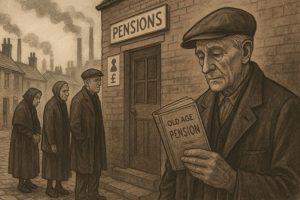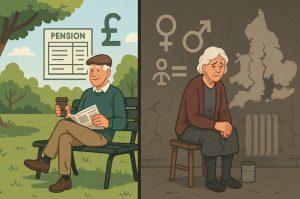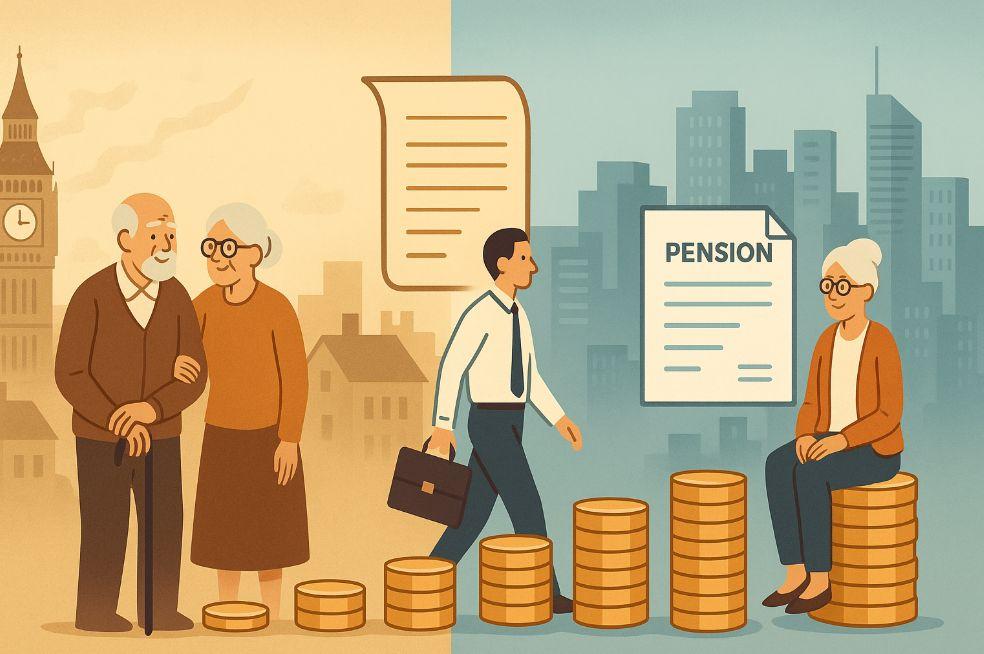The evolution of the UK pension system post-1951 marks a significant chapter in the nation’s socio-economic development. As the country recovered from World War II, a series of welfare reforms reshaped how retirement was planned and funded.
These pension changes have influenced generations of retirees and continue to impact today’s workforce. From the introduction of the Graduated Pension Scheme to the implementation of the Triple Lock, each reform was born out of economic necessity, political strategy, and social pressure.
Understanding these changes is crucial for anyone who wants to grasp how the UK pension system arrived at its current state.
How Did the UK Pension System Look Before 1951?

The Early Framework of the State Pension
Before 1951, the UK pension system was relatively modest. Introduced in 1908, the Old Age Pensions Act provided a means-tested benefit for those over 70. In 1925, contributory pensions were introduced under the Widows’, Orphans’ and Old Age Contributory Pensions Act. However, the system was limited in scope and coverage.
Post-War Welfare Reforms
The most pivotal moment came with the 1942 Beveridge Report, which laid the foundation for the modern welfare state. It proposed a comprehensive social insurance scheme, and by 1948, the National Insurance Act formalised a system where working individuals made contributions in exchange for state benefits, including pensions.
This marked a transition from a minimal safety net to a more structured, contributory model.
What Major Pension Reforms Occurred in the UK After 1951?
Graduated Pension Scheme (1959)
This scheme introduced earnings-related pensions funded by additional National Insurance contributions. The goal was to supplement the flat-rate basic pension with a portion reflecting workers’ income levels.
State Earnings-Related Pension Scheme (SERPS) – 1975
SERPS replaced the Graduated Pension Scheme and allowed employees to earn pension rights based on their salary above a certain threshold. It aimed to improve retirement incomes and reduce reliance on means-tested benefits.
Pension Reforms in the 1990s and 2000s
The 1995 Pensions Act began the process of equalising the state pension age for men and women. The 2007 and 2011 Pensions Acts further raised the retirement age and adjusted contribution thresholds. In 2016, the new State Pension system was launched, simplifying payments and eliminating SERPS for new retirees.
How Did Changes in Retirement Age Impact UK Workers?
Retirement Age Before and After Reforms
Initially, the state pension age was set at 65 for men and 60 for women. This disparity was challenged over time due to equality legislation and demographic pressures. The 1995 Pensions Act initiated the equalisation of the retirement age, which began in 2010 and concluded in 2018.
Implications for Workers
Raising the retirement age has meant that people now work longer before qualifying for a pension. While this helps manage the financial strain on public finances, it has sparked debates on fairness, particularly for those in manual labour or with shorter life expectancies.
What Role Did National Insurance Contributions Play in Pension Eligibility?

Contribution-Based Eligibility
To qualify for a full UK State Pension, individuals must have paid or been credited with a minimum number of years of National Insurance (NI) contributions. The 2016 reform set the bar at 35 qualifying years for the full new State Pension.
Changes Over Time
The contribution thresholds and qualifying rules have been adjusted several times. Gaps in contributions due to unemployment, caregiving, or illness can affect pension entitlements, although credits and voluntary contributions help mitigate this.
What is the Difference Between the Basic and New State Pension?
Comparison of Pension Systems
| Feature | Basic State Pension (Pre-2016) | New State Pension (Post-2016) |
| Qualifying Years | 30 years | 35 years |
| Pension Amount (2024/25) | Up to £156.20/week | Up to £221.20/week |
| Earnings-Related Component | Yes (through SERPS/S2P) | No |
| Simplicity | Complex (multiple components) | Simplified, single payment |
| Gender Disparity | Higher for men historically | Designed to reduce disparity |
The new system is easier to understand and aims to provide a fairer outcome, especially for self-employed individuals and those with inconsistent work histories. However, transitional arrangements have led to confusion for those caught between systems.
How Have Public Sector Pensions Evolved in the UK?
Defined Benefit vs. Defined Contribution
Public sector workers have traditionally received defined benefit (DB) pensions, guaranteeing a retirement income based on salary and years of service. Over the years, these schemes have come under scrutiny due to rising costs.
Recent Reforms and Challenges
Following reviews like the Hutton Report (2011), many public sector schemes have shifted from final salary to career average earnings calculations. Increased employee contributions and raised pension ages have also been introduced to ensure long-term sustainability.
How Does the Department for Work and Pensions (DWP) Influence Pension Policy?

Regulation and Oversight
The DWP is the central government department responsible for pensions. It oversees state pension distribution, sets contribution and eligibility rules, and manages reforms through legislation.
Key Reforms Initiated by DWP
Recent DWP-driven changes include automatic enrolment, the introduction of the new State Pension, and continued monitoring of the triple lock. The department also collaborates with HM Treasury and other agencies to ensure policy effectiveness.
What Impact Has Automatic Enrolment Had on Workers and Employers?
The Rise of Enrolment
Introduced in 2012, automatic enrolment requires employers to enroll eligible workers into workplace pension schemes. This reversed declining pension participation rates seen in the early 2000s.
Workforce and Business Outcomes
Automatic enrolment has significantly increased pension savings among younger and lower-income workers. However, it has also posed administrative and financial challenges for small businesses, particularly in compliance and matching contributions.
How Has the Pension Triple Lock Affected Retirees’ Incomes?
Understanding the Triple Lock
The triple lock guarantees that the State Pension increases each year by the highest of:
- Earnings growth
- Inflation (CPI)
- 2.5%
Economic Effects
While the triple lock has preserved pensioner incomes and reduced poverty among older people, it has also been criticised for its cost to public finances. Its future remains a subject of political debate, especially during fiscal constraints.
What Are the Current Inequalities in the UK Pension System?

Gender Disparities
Women often have lower pension savings due to career breaks, part-time work, and lower average earnings. Although reforms aim to address these gaps, the effects are gradual.
Other Inequities
Pension outcomes vary by region, ethnicity, and employment type. Workers in gig economy roles or with fragmented work histories often find themselves underprepared for retirement, despite automatic enrolment efforts.
What Does the Future Look Like for UK Pensions?
Predictions and Proposals
With increasing life expectancy and a shrinking workforce, the pressure on pensions will only grow. Future reforms may include further rises in retirement age, adjustments to the triple lock, and new savings incentives.
The Need for Awareness
Individuals must take greater responsibility for their retirement planning. Government and private-sector collaboration will be crucial in ensuring that pensions remain viable and equitable for future generations.
How Have Occupational Pension Schemes Changed Since 1951?
Growth and Diversification
Occupational pension schemes in the UK have seen tremendous evolution since the early 1950s. Initially, they were primarily offered by large employers in sectors like public services, banking, and manufacturing. These schemes were often defined benefit (DB), promising a fixed income in retirement based on salary and years of service.
Over time, economic and demographic pressures led many employers to shift towards defined contribution (DC) schemes. Under this model, the pension amount depends on the contributions made and investment performance. This shift reduced long-term liabilities for employers but increased risk for employees, who must now manage their pension savings more actively.
Legislative Impact and Regulation
The Pensions Act 1995 introduced greater regulation, requiring schemes to adhere to funding standards and to appoint trustees. The 2004 Pensions Act created the Pensions Regulator to oversee workplace schemes and introduced the Pension Protection Fund (PPF) to protect members if their employer failed.
These legislative changes ensured greater transparency and security for scheme members, but they also increased the complexity of managing workplace pensions. Employers now must comply with rigorous governance and reporting standards.
Why is It Important to Understand UK Pension History Today?

Learning from the Past
Understanding the trajectory of UK pension changes post-1951 is not just a historical exercise. it offers valuable insight into current policy decisions and individual retirement planning. Each reform, from the introduction of SERPS to the new State Pension system, reflects responses to economic shifts, political ideology, and demographic trends.
For example, the rising State Pension age was introduced partly to reflect longer life expectancy. Similarly, automatic enrolment emerged as a solution to declining personal pension savings. These historical contexts help explain current policy debates and highlight patterns in government responses.
Better Planning for the Future
With frequent changes in retirement age, eligibility, and benefit calculations, understanding past reforms can help workers better anticipate what lies ahead. Being informed about the evolution of pensions empowers individuals to make smarter financial choices and prepare for a more stable retirement.
Conclusion
The landscape of UK pensions has undergone profound transformation since 1951, shaped by legislative reforms, economic pressures, and shifting societal needs.
From the introduction of contributory systems to the rise of automatic enrolment and changes in retirement age, each milestone has left a lasting impact on both retirees and the workforce.
As the population continues to age and financial priorities evolve, understanding the history of UK pension changes is essential for anyone planning their future. Staying informed, proactive, and engaged with policy developments remains the key to securing a stable and sustainable retirement.
FAQs UK Pension Changes
What is the full new State Pension amount in 2025?
As of the 2024/25 tax year, the full new State Pension is £221.20 per week, provided an individual has 35 qualifying years of NI contributions.
Can someone still receive SERPS today?
Yes, people who reached State Pension age before April 6, 2016, may still receive SERPS as part of their pension payments.
How can I check my pension entitlement in the UK?
You can use the government’s online service to view your State Pension forecast and check your National Insurance record.
What happens if I have gaps in my NI contributions?
Gaps may reduce your pension, but you can often make voluntary contributions or receive credits to fill them.
Are workplace pensions mandatory?
Employers are legally required to automatically enrol eligible employees into a workplace pension and make contributions on their behalf.
Is the State Pension enough to live on in retirement?
The State Pension alone may not be sufficient for most individuals. Private and workplace pensions are essential for a comfortable retirement.
What age will I get my State Pension if I’m under 40?
If you’re under 40, your State Pension age is likely to be between 67 and 68, but future changes could raise it further.









Leave feedback about this